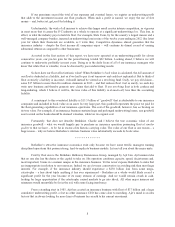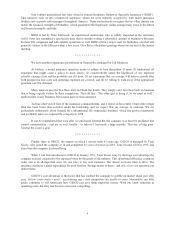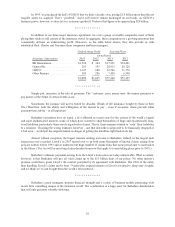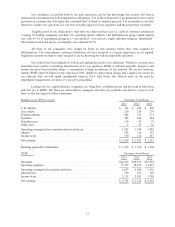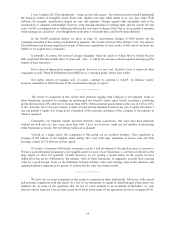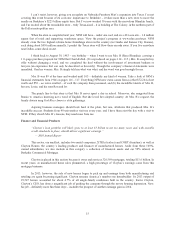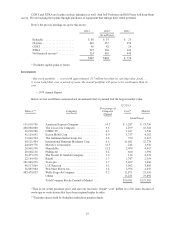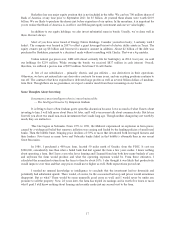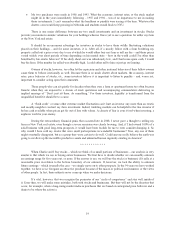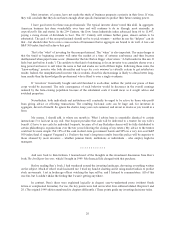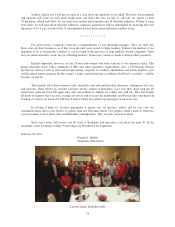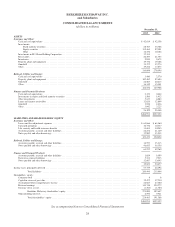Berkshire Hathaway 2013 Annual Report Download - page 20
Download and view the complete annual report
Please find page 20 of the 2013 Berkshire Hathaway annual report below. You can navigate through the pages in the report by either clicking on the pages listed below, or by using the keyword search tool below to find specific information within the annual report.In 1993, I made another small investment. Larry Silverstein, Salomon’s landlord when I was the
company’s CEO, told me about a New York retail property adjacent to NYU that the Resolution Trust Corp. was
selling. Again, a bubble had popped – this one involving commercial real estate – and the RTC had been created to
dispose of the assets of failed savings institutions whose optimistic lending practices had fueled the folly.
Here, too, the analysis was simple. As had been the case with the farm, the unleveraged current yield from
the property was about 10%. But the property had been undermanaged by the RTC, and its income would increase
when several vacant stores were leased. Even more important, the largest tenant – who occupied around 20% of the
project’s space – was paying rent of about $5 per foot, whereas other tenants averaged $70. The expiration of this
bargain lease in nine years was certain to provide a major boost to earnings. The property’s location was also
superb: NYU wasn’t going anywhere.
I joined a small group, including Larry and my friend Fred Rose, that purchased the parcel. Fred was an
experienced, high-grade real estate investor who, with his family, would manage the property. And manage it they
did. As old leases expired, earnings tripled. Annual distributions now exceed 35% of our original equity
investment. Moreover, our original mortgage was refinanced in 1996 and again in 1999, moves that allowed several
special distributions totaling more than 150% of what we had invested. I’ve yet to view the property.
Income from both the farm and the NYU real estate will probably increase in the decades to come. Though
the gains won’t be dramatic, the two investments will be solid and satisfactory holdings for my lifetime and,
subsequently, for my children and grandchildren.
I tell these tales to illustrate certain fundamentals of investing:
ŠYou don’t need to be an expert in order to achieve satisfactory investment returns. But if you aren’t, you
must recognize your limitations and follow a course certain to work reasonably well. Keep things simple
and don’t swing for the fences. When promised quick profits, respond with a quick “no.”
ŠFocus on the future productivity of the asset you are considering. If you don’t feel comfortable making a rough
estimate of the asset’s future earnings, just forget it and move on. No one has the ability to evaluate every
investment possibility. But omniscience isn’t necessary; you only need to understand the actions you undertake.
ŠIf you instead focus on the prospective price change of a contemplated purchase, you are speculating.
There is nothing improper about that. I know, however, that I am unable to speculate successfully, and I
am skeptical of those who claim sustained success at doing so. Half of all coin-flippers will win their first
toss; none of those winners has an expectation of profit if he continues to play the game. And the fact that
a given asset has appreciated in the recent past is never a reason to buy it.
ŠWith my two small investments, I thought only of what the properties would produce and cared not at all
about their daily valuations. Games are won by players who focus on the playing field – not by those
whose eyes are glued to the scoreboard. If you can enjoy Saturdays and Sundays without looking at stock
prices, give it a try on weekdays.
ŠForming macro opinions or listening to the macro or market predictions of others is a waste of time.
Indeed, it is dangerous because it may blur your vision of the facts that are truly important. (When I hear
TV commentators glibly opine on what the market will do next, I am reminded of Mickey Mantle’s
scathing comment: “You don’t know how easy this game is until you get into that broadcasting booth.”)
18


